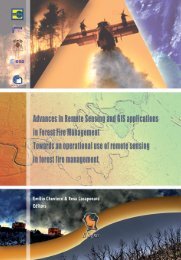EARSeL Newsletter - EARSeL, European Association of Remote ...
EARSeL Newsletter - EARSeL, European Association of Remote ...
EARSeL Newsletter - EARSeL, European Association of Remote ...
Create successful ePaper yourself
Turn your PDF publications into a flip-book with our unique Google optimized e-Paper software.
<strong>EARSeL</strong> <strong>Newsletter</strong> September 2002 - Number 51<br />
22<br />
Earth's gravity field since 1997. Since 1997 researchers<br />
have noticed a change in the way Earth's<br />
gravity field bulges – i.e. an increasing upward bulge<br />
at the equator. Observations <strong>of</strong> the Earth's gravity<br />
field show that some phenomena are counteracting<br />
the gravitational effects <strong>of</strong> PGR, and researchers are<br />
looking to the ocean for answers<br />
4.8 Grace’s first Earth gravity maps<br />
(NASA/DLR)<br />
On 12th September 2002 it was reported<br />
that, six months into their mission to measure<br />
precisely the Earth's shifting water<br />
masses and to map their effects on Earth's<br />
gravity field, the twin Grace (Gravity Recovery<br />
and Climate Experiment) satellites<br />
are already producing results <strong>of</strong> considerable<br />
interest. Using just fourteen days <strong>of</strong><br />
data from Grace (a joint NASA / German<br />
Aerospace Centre mission), a preliminary<br />
Grace gravity field map has already been<br />
produced, and is proving to be substantially<br />
more accurate than the combined results<br />
<strong>of</strong> more than three decades <strong>of</strong> satellite and<br />
surface instrument gravity measurements<br />
collected before Grace.<br />
Grace Principal Investigator Dr. Byron Tapley<br />
<strong>of</strong> the University <strong>of</strong> Texas Centre for<br />
Space Research in Austin, said: "In addition<br />
to improving our knowledge <strong>of</strong> Earth's<br />
mean gravity field, the ability to measure<br />
time variations in gravity will be a new and<br />
important Grace contribution." According<br />
to Dr. Michael Watkins, Grace Project Scientist<br />
at NASA's Jet Propulsion Laboratory,<br />
Pasadena, California: "This first Grace<br />
gravity field data is about ten times more<br />
accurate for large-scale features than any<br />
pre-Grace gravity model <strong>of</strong> Earth. While<br />
these first fields are already extremely<br />
promising, we expect to do up to ten times<br />
better after we perform additional calibrations<br />
<strong>of</strong> the instruments." Dr. Christoph<br />
Reigber, Grace Co-Principal Investigator at<br />
the German Geo-Research Centre, and<br />
Principal Investigator for the German<br />
Champ (Challenging Mini-Satellite Payload)<br />
mission, stated: "The Grace mission<br />
will soon demonstrate its mission goal to<br />
help us to understand better how variations<br />
in Earth's gravity field reflect changes<br />
in climate." Champ was launched two<br />
years ago as the first in a series <strong>of</strong> dedicated<br />
Earth gravity field missions planned for<br />
this decade, and is operating in parallel<br />
with Grace.<br />
Launched on 17th March 2002, Grace senses<br />
minute variations in Earth's surface<br />
mass and corresponding variations in<br />
Earth's gravitational pull. The monthly<br />
gravity maps generated by Grace will be<br />
up to 1,000 times more accurate than current<br />
maps, substantially improving the accuracy<br />
<strong>of</strong> many techniques used by<br />
oceanographers, hydrologists, glaciologists,<br />
geologists and other scientists to<br />
study phenomena that influence climate.<br />
Among the first and most important applications<br />
for Grace's data will be to improve<br />
our understanding <strong>of</strong> global ocean circulation.<br />
The hills and valleys in the ocean's<br />
surface are due to currents and variations<br />
in Earth's gravity field. Grace enables separation<br />
<strong>of</strong> those two effects to better measure<br />
ocean currents and their effect on<br />
climate. Dr. Lee-Lueng Fu, Topex / Poseidon<br />
and Jason-1 Project Scientist at JPL,<br />
commented: "These first results from Grace<br />
look very promising from an oceanographic<br />
point <strong>of</strong> view. Even with this preliminary<br />
gravity field, Grace has enabled us to use<br />
Topex / Poseidon and Jason-1 data to determine<br />
ocean circulation features more accurately."<br />
Grace measures Earth's gravity field by<br />
measuring the separation between the twin<br />
satellites with an accuracy <strong>of</strong> one millionth<br />
<strong>of</strong> a metre (less than one-tenth <strong>of</strong> the width<br />
<strong>of</strong> a human hair). Grace's instruments must<br />
all work together and be very accurately<br />
calibrated and aligned, a process the Grace<br />
project is just now completing during the<br />
mission's commissioning phase, which<br />
began in early April 2002. Science instruments<br />
and supporting systems such as
















